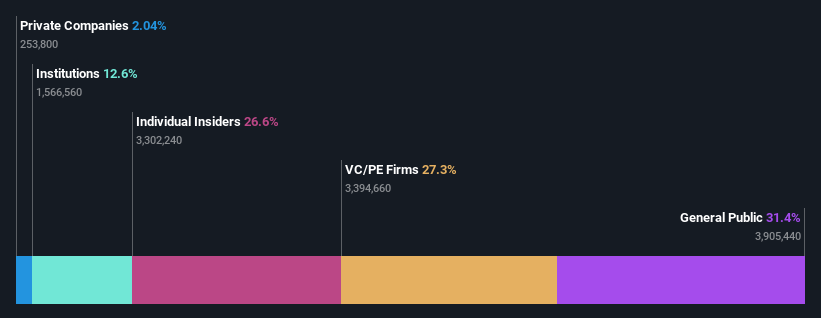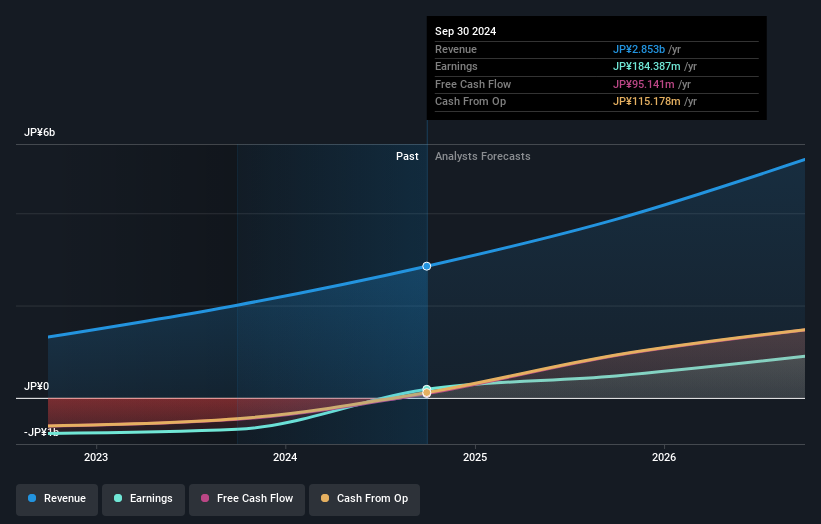- Japan
- /
- Consumer Services
- /
- TSE:264A
Individual investors in Schoo,inc. (TSE:264A) are its biggest bettors, and their bets paid off as stock gained 15% last week

Key Insights
- Significant control over Schooinc by individual investors implies that the general public has more power to influence management and governance-related decisions
- The top 6 shareholders own 51% of the company
- 27% of Schooinc is held by insiders
If you want to know who really controls Schoo,inc. (TSE:264A), then you'll have to look at the makeup of its share registry. We can see that individual investors own the lion's share in the company with 31% ownership. That is, the group stands to benefit the most if the stock rises (or lose the most if there is a downturn).
Clearly, individual investors benefitted the most after the company's market cap rose by JP¥2.6b last week.
Let's delve deeper into each type of owner of Schooinc, beginning with the chart below.
Check out our latest analysis for Schooinc

What Does The Institutional Ownership Tell Us About Schooinc?
Many institutions measure their performance against an index that approximates the local market. So they usually pay more attention to companies that are included in major indices.
Schooinc already has institutions on the share registry. Indeed, they own a respectable stake in the company. This implies the analysts working for those institutions have looked at the stock and they like it. But just like anyone else, they could be wrong. If multiple institutions change their view on a stock at the same time, you could see the share price drop fast. It's therefore worth looking at Schooinc's earnings history below. Of course, the future is what really matters.

We note that hedge funds don't have a meaningful investment in Schooinc. Kenshiro Mori is currently the company's largest shareholder with 19% of shares outstanding. Meanwhile, the second and third largest shareholders, hold 9.0% and 6.9%, of the shares outstanding, respectively.
We also observed that the top 6 shareholders account for more than half of the share register, with a few smaller shareholders to balance the interests of the larger ones to a certain extent.
While studying institutional ownership for a company can add value to your research, it is also a good practice to research analyst recommendations to get a deeper understand of a stock's expected performance. There is a little analyst coverage of the stock, but not much. So there is room for it to gain more coverage.
Insider Ownership Of Schooinc
The definition of an insider can differ slightly between different countries, but members of the board of directors always count. Company management run the business, but the CEO will answer to the board, even if he or she is a member of it.
I generally consider insider ownership to be a good thing. However, on some occasions it makes it more difficult for other shareholders to hold the board accountable for decisions.
Our most recent data indicates that insiders own a reasonable proportion of Schoo,inc.. It has a market capitalization of just JP¥20b, and insiders have JP¥5.4b worth of shares in their own names. This may suggest that the founders still own a lot of shares. You can click here to see if they have been buying or selling.
General Public Ownership
The general public-- including retail investors -- own 31% stake in the company, and hence can't easily be ignored. While this group can't necessarily call the shots, it can certainly have a real influence on how the company is run.
Private Equity Ownership
With an ownership of 27%, private equity firms are in a position to play a role in shaping corporate strategy with a focus on value creation. Some investors might be encouraged by this, since private equity are sometimes able to encourage strategies that help the market see the value in the company. Alternatively, those holders might be exiting the investment after taking it public.
Next Steps:
It's always worth thinking about the different groups who own shares in a company. But to understand Schooinc better, we need to consider many other factors. For example, we've discovered 1 warning sign for Schooinc that you should be aware of before investing here.
Ultimately the future is most important. You can access this free report on analyst forecasts for the company.
NB: Figures in this article are calculated using data from the last twelve months, which refer to the 12-month period ending on the last date of the month the financial statement is dated. This may not be consistent with full year annual report figures.
New: Manage All Your Stock Portfolios in One Place
We've created the ultimate portfolio companion for stock investors, and it's free.
• Connect an unlimited number of Portfolios and see your total in one currency
• Be alerted to new Warning Signs or Risks via email or mobile
• Track the Fair Value of your stocks
Have feedback on this article? Concerned about the content? Get in touch with us directly. Alternatively, email editorial-team (at) simplywallst.com.
This article by Simply Wall St is general in nature. We provide commentary based on historical data and analyst forecasts only using an unbiased methodology and our articles are not intended to be financial advice. It does not constitute a recommendation to buy or sell any stock, and does not take account of your objectives, or your financial situation. We aim to bring you long-term focused analysis driven by fundamental data. Note that our analysis may not factor in the latest price-sensitive company announcements or qualitative material. Simply Wall St has no position in any stocks mentioned.
About TSE:264A
Exceptional growth potential with adequate balance sheet.
Market Insights
Community Narratives




